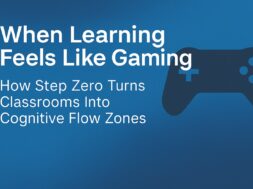Unlocking the power of intuitive thinking to transform maths from memorized steps to meaningful discovery.
1. Mathematical Intuition is Pattern Recognition
The brain’s “gut feel” in maths is often fast, subconscious dot-connecting based on prior experiences.
A learner may not recall the rule behind
49 ÷ 7 = 7, but it “feels right.”
In algebra, they may sense that factoring is the right step before they consciously decide it.
That’s not luck. It’s the brain’s built-in intelligence working like a mental GPS — detecting the direction before the route is mapped.
This is intuition as neural patterning — dots lighting up from earlier learning.
2. Intuition Is the Seed of Insight
Einstein captured it best:
“The intuitive mind is a sacred gift and the rational mind is a faithful servant.”
In maths, intuition often sparks the first connection:
- “What if I try this?”
- “This feels similar to something I’ve done.”
- “There’s something off here…”
This gutfeel is the birthplace of insight, discovery, and innovation.
It’s how the brain begins to draw bridges between disconnected facts — before formal logic kicks in.
3. Over-Reliance on Rules Kills Intuition
Traditional maths teaching drills:
- Procedures
- Recipes
- Memorised rules
This forces learners to follow steps without ever seeing the big picture.
It’s like walking dot-to-dot with no idea what picture you’re drawing.
By contrast, a figure-out approach, like Thinking Tools, activates intuition.
It invites learners to notice patterns, connect ideas, and then apply steps that make sense.
This empowers learners to make meaning, not just do maths.
4. The Brain Craves Meaning, Not Just Accuracy
The brain’s mothership of thinking is wired to:
- Compare
- Detect cause and effect
- Classify and map relationships
When these cognitive systems are engaged, learners start joining the dots across concepts — leading to that magical feeling of “Now I see!”
True intuition is the outcome of deep mental connections.
It can’t be handed to learners in one lesson.
It must be grown through thinking.
5. Even Mathematicians Trust Intuition
Mathematicians often say:
“I just had a feeling this would work.”
Even in high-level mathematics, intuition plays a central role in:
- Sensing which approach might unlock a solution
- Feeling when an answer is off, even if the steps seem right
- Making creative leaps across domains
These moments are powered by thousands of invisible dots — connected over years of meaningful thinking.
Final Thought
A gutfeel in maths is not a guess.
It’s the quiet voice of a brain that has:
- Noticed patterns
- Connected structures
- Built internal meaning
…and is now beginning to trust itself.
Intuition is what happens when enough dots connect — and the picture begins to appear.





